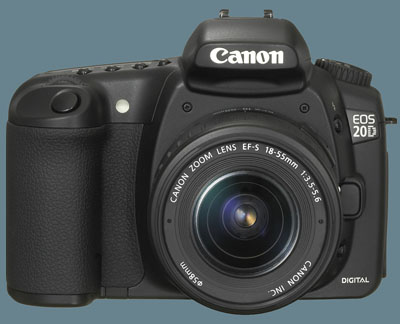




 CMOS Sensor
CMOS Sensor22.5mm x 15.0mm Imager 8.5 Million Total Pixels 8.25 Million Effective Pixels ISO 100-1600 5fps 23 JPEG / 6 RAW Buffer 30sec - 1/8000sec Shutter MSRP: $1,499.00 USD |
Canon 20D (August 20, 2004) |
Canon has upgraded their 10D DSLR in many different areas, and their latest offering, the 20D, is part of Canon's technology revolution. This was first seen with the 1D MK II, and we are seeing it again with the 20D. Viewing the latest photo samples available, it appears as if Canon is winning the War on Noise.
First Impressions
If you couldn't quite manage $4500 for a Quick-N-Sporty 8MP DSLR, the 20D has come along in just the nick of time to take a mere $1500 out of your wallet. Many improvements over the 10D have been implemented and probably the most technologically advanced feature of the 20D, is the lack of noise in the images. More tests, samples, reviews, and all the usual protocols will need to be done for a definitive answer to this, but so far, the images are pretty good for the amount of pixels on the 20D sensor. Let's take a look at the list of some of the major new features:
5 Frames-Per-Second
It's kind of nice seeing 5fps on a camera that is below $1500. 5fps is pretty darn quick, and if you need something faster, well, there is the $4500 1D Mark II.
9 AF Points
You just can't refuse more AF points when they are offered. I would have preferred 11 AF Points, but 9 is certainly better than 7 which was on the 10D, and much better than the 5 AF points on the Nikon D70 and D100.
USB 2.0
I'm not sure why Canon put USB 2.0 in their 20D instead of Firewire, but anything is better than USB 1.1 speeds when you're transferring a gigabyte of image data or more.
23 JPEG or 6 RAW?
There is still a little uncertainty on the actual amount of RAW images the 20D can write in the buffer. Canon says 6 RAW, but writing RAW and RAW+JPEG are totally different things. Writing only in RAW, is 8.7MB per file, while writing RAW+JPEG is 12.3MB. You would think the buffer would allow for more RAW images to be written than RAW+JPEG images. We'll just have to see when the camera is actually released or someone experiments and tries this. |
| ©2004 DigitalDingus. All rights reserved. |
 Canon has crafted a brand new sensor for the 20D. Putting 8.2 million pixels on an APS-C sensor is not easy. The size of the pixels are 6.4 microns. Now, if you've been reading some of my articles on pixel sizes, you will know that this is a small size for a DSLR pixel--currently, it's the smallest (The Olympus E-1 had the smallest pixel size for a DSLR at 6.8 microns). From the images seen so far, it looks as if Canon has brought about new technology to reduce noise at a smaller pixel size. I think this was probably mandatory on Canon's part, because the 1Ds MK II is going to be announced in the future, and they needed a reliable small pixel size to fit on a brand new full-frame sensor. This makes me believe the 1Ds MK II will indeed be around 16MP.
Canon has crafted a brand new sensor for the 20D. Putting 8.2 million pixels on an APS-C sensor is not easy. The size of the pixels are 6.4 microns. Now, if you've been reading some of my articles on pixel sizes, you will know that this is a small size for a DSLR pixel--currently, it's the smallest (The Olympus E-1 had the smallest pixel size for a DSLR at 6.8 microns). From the images seen so far, it looks as if Canon has brought about new technology to reduce noise at a smaller pixel size. I think this was probably mandatory on Canon's part, because the 1Ds MK II is going to be announced in the future, and they needed a reliable small pixel size to fit on a brand new full-frame sensor. This makes me believe the 1Ds MK II will indeed be around 16MP.